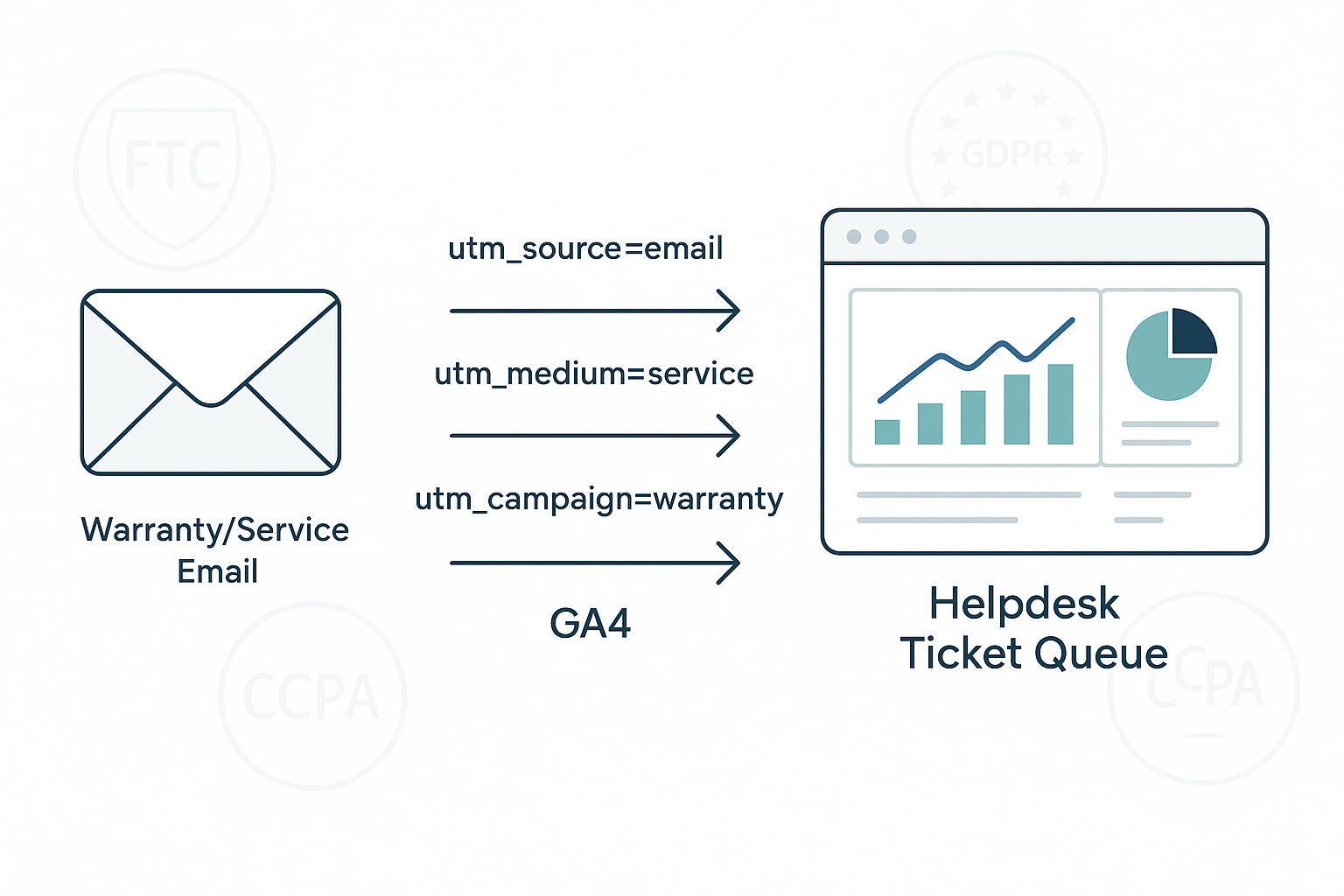How To Track Warranty and Service Emails in Electronics Ecommerce

Whether you run a DTC electronics brand or manage support operations, this guide shows you exactly how to track warranty and service emails across GA4, Klaviyo, and your helpdesk (Zendesk or Gorgias). By the end, you’ll reliably attribute email clicks to service outcomes, auto-tag warranty tickets, and report on SLAs and CSAT without mixing promotional content.
- Time: 2–4 hours for initial setup; 30–60 minutes for verification
- Difficulty: Intermediate (requires admin access in GA4, Klaviyo, and your helpdesk)
- Prerequisites: Access to GA4 Admin, Klaviyo Flows, and Zendesk/Gorgias admin; basic understanding of UTMs
Step 1: Nail the definitions — transactional vs marketing
Start by separating service/transactional emails from marketing. This determines consent, unsubscribe, and content rules.
- Transactional/relationship emails facilitate or confirm an agreed-upon action (e.g., warranty registration confirmation, RMA status), and they’re treated differently from commercial messages. The U.S. classification hinges on the “primary purpose test.” According to the FTC CAN-SPAM business guide (updated overview), if the subject line and leading content are promotional, the email must meet commercial requirements (clear opt-out, accurate routing, truthful subject line, physical postal address), and opt-outs must be honored within 10 business days.
- For EU data protection, many warranty/service emails are supported by lawful bases such as performance of a contract. See GDPR Article 6 (EUR-Lex) and apply principles like purpose limitation and data minimization from GDPR Article 5. Keep content strictly service-related and avoid repurposing data for marketing without a separate lawful basis.
- If you operate in California, understand consumer rights around selling/sharing personal data and global privacy controls. The California AG’s CCPA overview outlines obligations; maintain records of requests and minimize verification data.
From experience: Don’t add promo banners or upsell copy to service emails. It risks flipping the “primary purpose” to marketing, which changes compliance and deliverability expectations.
Step 2: Configure measurement in GA4 for warranty/service emails
Your goal is for clicks from warranty/service emails to classify as the Email channel and to attribute downstream support actions correctly.
-
Standardize UTMs for service emails.
- Use lowercase and stick to GA4 defaults. Set
utm_medium=emailfor all warranty/service emails; changing it (e.g.,utm_medium=service) can push traffic into Unassigned unless you create custom channel groups. - Example:
https://yourbrand.com/support/rma?utm_source=postpurchase&utm_medium=email&utm_campaign=warranty-activation
- Use lowercase and stick to GA4 defaults. Set
-
Optional: Create a custom channel group (if you must use non-standard mediums).
- In GA4 Admin, create a new Channel group and define a rule for your chosen medium (e.g., Session medium exactly matches
service). This affects future data only. - GA4’s default channel groups segment traffic based on source/medium. See Google’s explanation of traffic-source dimensions in GA4 and remember classification relies heavily on UTM parameters.
- In GA4 Admin, create a new Channel group and define a rule for your chosen medium (e.g., Session medium exactly matches
-
Track key service events.
- Implement events for warranty registration, RMA form submit, service scheduling, or “contact support” conversions. Use consistent event names and parameters (e.g.,
warranty_register,rma_submit,service_scheduled).
- Implement events for warranty registration, RMA form submit, service scheduling, or “contact support” conversions. Use consistent event names and parameters (e.g.,
-
Validate classification and attribution.
- Open GA4 DebugView and click your test warranty email link. Confirm the session and UTM parameters appear; then check Reports > Acquisition > Traffic acquisition. Filter Default channel group = Email and verify your session/conversions.
Tips
- If UTMs get stripped by redirects, add them to the final destination and test with incognito. Keep
utm_sourcedescriptive (postpurchase, support) andutm_campaignclear (warranty-activation, rma-update).
Step 3: Build transactional flows in Klaviyo
Create flows that send strictly service-related emails and apply for transactional status when eligible.
-
Design triggers and content.
- Typical triggers: Placed Order, Fulfilled Order, warranty claim form submission (via integration or custom event), and repair status updates.
- Personalize with dynamic fields (order number, product model, claim ID). Keep copy strictly service-related.
-
Apply for transactional status (email/SMS where eligible).
- In Klaviyo: Flows > open the flow > select the message > Apply for transactional status > submit for review. If you edit after approval, you must re-apply.
- Learn definitions and eligibility in Klaviyo’s guide to transactional messages.
-
Verify delivery and engagement.
- Use a test profile to send previews and live tests. In the message’s Analytics/Activity, confirm Delivered, Opened, Clicked. Keep an eye on bounce and complaint rates.
If rejected: Remove promotional elements, align subject/body to the service purpose, ensure it’s triggered by appropriate metrics, and re-submit.
Step 4: Set up helpdesk workflows (Zendesk or Gorgias)
You’ll auto-tag warranty tickets, route them to the right queue, enforce SLAs (Zendesk), and collect CSAT.
Zendesk setup
-
Enable tags and create auto-tag triggers.
- Admin Center > Objects and rules > Business rules > Triggers > Add trigger. Conditions: Ticket is Created; Subject/Description contains “warranty,” form equals “Warranty Claim.” Actions: Add tags
warranty,service_request. Follow Zendesk’s trigger creation guide.
- Admin Center > Objects and rules > Business rules > Triggers > Add trigger. Conditions: Ticket is Created; Subject/Description contains “warranty,” form equals “Warranty Claim.” Actions: Add tags
-
Build macros for standard responses.
- Create macros that insert standardized replies (claim received, next steps), set status/priority, and add tags.
-
Create views (queues) for warranty tickets.
- Filter by tag
warranty, status New/Open, and show SLA columns.
- Filter by tag
-
Configure SLA policies.
- Set First reply time (e.g., 2 business hours) and Resolution time targets, scoped to tickets with tag
warranty. Zendesk explains SLA metrics and application in their docs; start with achievable targets and iterate.
- Set First reply time (e.g., 2 business hours) and Resolution time targets, scoped to tickets with tag
-
Enable CSAT and reporting.
- Turn on customer satisfaction surveys and review scores on dashboards. Use Explore for breakdowns by agent or tag.
Verification in Zendesk
- Open a test ticket via email containing “warranty” keywords. Confirm tags applied, ticket routed to the warranty view, SLA badge active, and CSAT survey sends post-resolution.
Gorgias setup
-
Create Rules for auto-tagging and routing.
- Settings > Productivity > Rules > Add rule. WHEN Ticket Created; IF message contains “warranty”; THEN Add Tag
warranty; Assign to the Warranty team. See Gorgias Rules documentation.
- Settings > Productivity > Rules > Add rule. WHEN Ticket Created; IF message contains “warranty”; THEN Add Tag
-
Build Views filtered by tags.
- Create View with filter: Tags contains
warranty. Show priority and assignee columns.
- Create View with filter: Tags contains
-
CSAT reporting.
- Use CSAT reports to monitor satisfaction on warranty tickets and identify coaching opportunities.
Note on SLAs in Gorgias
- Gorgias does not document native SLA countdown timers comparable to Zendesk. Use Rules and Views to emulate escalations for overdue tickets, or consider external tooling if strict SLAs are mandatory.
Optional: Close attribution gaps with server-side tracking
If you need to unify journeys across email clicks and downstream service outcomes beyond client-side tracking, consider server-side event feeds.
- Attribuly can be used to complement GA4 and Klaviyo with server-side tracking and integrations to unify attribution across channels and tools. Disclosure: Attribuly is our product.
From experience: Server-side feeds help when browsers block client-side cookies or UTMs get lost through redirects. Use them as a complement, not a replacement, to your GA4 and ESP setups.
End-to-end verification checklist
Do this once per flow and repeat after any major change.
- Send the test warranty/service email to yourself and click through the tagged link.
- GA4: Confirm session in DebugView and verify classification under Default channel group = Email in Traffic acquisition.
- Klaviyo: Confirm transactional status approved; check Delivered/Open/Click in the message analytics.
- Helpdesk: Verify auto-tag added, ticket appears in warranty view; Zendesk: SLA badge/timer running; Gorgias: rules executed and view placement correct.
Report the right KPIs
Track operational metrics that reflect service quality, not just marketing engagement.
- Email: Delivery rate, Open rate, CTR on support links, Bounce/complaint rate.
- GA4: Sessions from Email, conversions tied to service events (e.g.,
rma_submit), and assisted conversions from Email. - Helpdesk: First reply time (FRT), Full resolution time, Reopen rate, CSAT for warranty tickets, Ticket volume by tag.
Targets
- Start with FRT: 1–4 business hours; Resolution: 2–5 business days; CSAT: 85–95%. Treat these as internal goals and adjust per product complexity.
Troubleshooting playbook
-
GA4 shows Unassigned for email clicks
- Confirm
utm_medium=emailexactly; check case; ensure UTMs aren’t stripped. If you must use a different medium, create a custom channel group rule and retest.
- Confirm
-
Klaviyo transactional status rejected
- Remove any promotional elements; ensure subject/body are strictly service-related; verify the triggering metric is eligible; re-submit.
-
Helpdesk tags missing
- Review trigger/rule conditions; test with clear keywords; confirm tag feature enabled; check ticket events to confirm actions fired.
-
No SLA timers in Gorgias
- Use Rules to escalate based on elapsed time, and Views to surface overdue tickets. If strict SLAs are required, consider Zendesk or external trackers.
Platform-agnostic alternatives
- ESPs other than Klaviyo: Most ESPs provide transactional flags or separate transactional streams (API/SMTP). Keep content service-only, and verify message logs (delivered, opens, clicks).
- Helpdesks other than Zendesk/Gorgias: Implement rules/tags/views for warranty intents and build SLA-like processes with internal timers or external apps.
Governance and SOPs
- Create an SOP for UTMs, events, helpdesk tags, and SLA settings. Store change logs and audit monthly.
- Review compliance periodically: primary purpose test for service emails, lawful basis for processing, and regional privacy requirements.
- Run quarterly verification: send test emails, validate GA4 classification, spot-check helpdesk tags and CSAT.
References
- GA4 channel grouping relies on traffic source/medium; see Google’s traffic-source dimensions. Validate sessions and events in GA4 DebugView.
- Learn transactional definitions and eligibility in Klaviyo’s transactional messages guide.
- Build warranty auto-tagging with Zendesk’s trigger guide or Gorgias Rules documentation.
- Compliance guardrails: FTC CAN-SPAM guide, GDPR Article 6, California AG’s CCPA overview.
